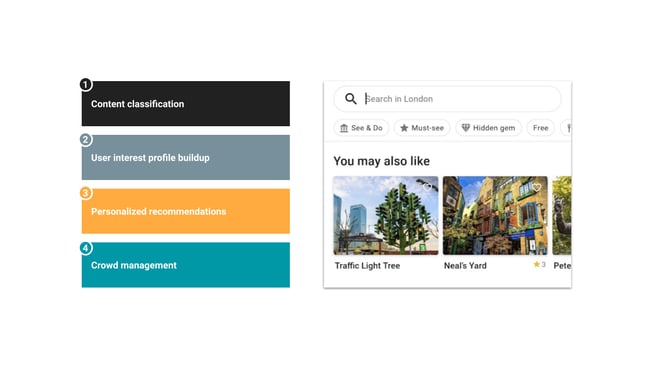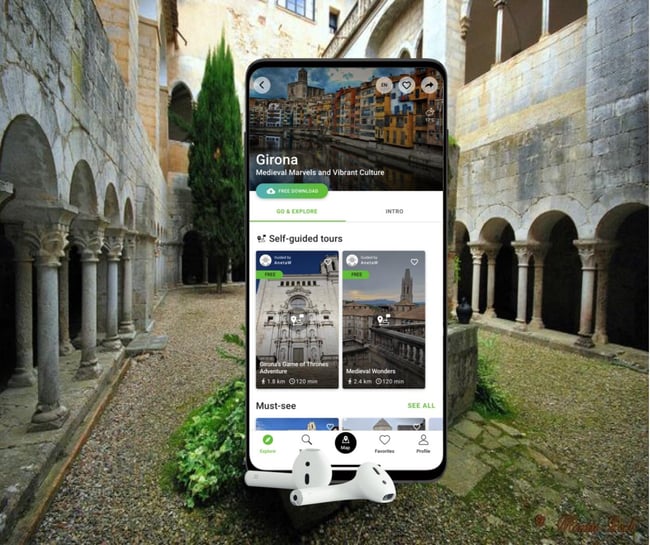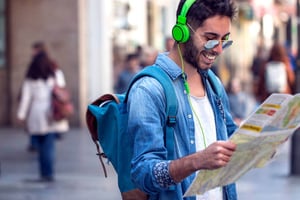One of the factors that truly sets a good digital audio guide apart is an engaging and relatable...
Get engaging, funny, and accurate digital travel guide content with SmartGuide AI
SmartGuide's AI-powered platform is changing the travel industry by providing highly engaging and accurate travel guide content. With advanced AI features and technology, the world's #1 digital travel guide platform is offering personalized AI recommendations to travelers. SmartGuide ensures that travelers receive accurate and up-to-date information about their destination in an engaging way, enhancing their overall experience.

A visitor completely absorbed in SmartGuide AI-driven engaging travel guide content
By leveraging advanced generative AI, SmartGuide has been encouraging tourism boards and destination management organizations to promote lesser-known places and attractions, distribute tourist traffic more evenly, and provide personalized recommendations, all while maintaining the highest standards of content quality and authenticity.
 SmartGuide's AI recommendations
SmartGuide's AI recommendations
Let's look at the benefits, but also the limitations of generative language models in creating travel guide content, and what SmartGuide does to reduce them.
Exploring the boundaries of Generative Language Models in travel guide content creation
Generative Language Models, like ChatGPT and Google Bard, have brought AI content generation tools to the broad public and enabled the production of human-like content output based on the prompts and input they receive. However, despite being groundbreaking, these AI tools present certain constraints in practical usage that can't be ignored.
A major challenge faced by these models is their tendency to "hallucinate". While they can generate engaging content, the authenticity of the information they produce can't always be guaranteed. The limitation lies in their design; they generate text based on patterns in the data they have been trained on, not on 100% verified information. Therefore, there's a risk of producing content that's factually incorrect or misleading, unless corrective measures are taken.
For instance, when asked to write about the Gironetta Tower in Girona, the model without special training in producing factual information described it as an imposing structure, despite it being nothing more than a ruin. This is because towers are commonly described as imposing structures, and the model learned this pattern.

Girona (Spain) on SmartGuide - the world's #1 digital audio travel guide
Another limitation of generative language models is their tendency to generate patterns and repetitive content. This can make reading the generated travel guides monotonous and less engaging for the end user. Since these models focus on pattern recognition, they can fall into a loop of repeating similar structures or phrases, detracting from the diversity and richness of the content.
For instance, when asked to write about the old city hall in Passau, the content was excellent. However, when asked to describe the new city hall, it simply stated that it replaced the old city hall and repeated most of the text about the old city hall from before. Similarly, when asked to write about the main square, it emphasized that the old city hall was the most important structure there, repeating the same text once again.
Accurate instructions and double fact-checking as a workaround
One of the essential components of generating engaging, valuable, and factual content with generative language models is providing accurate instructions and knowledgebase.
Detailed, clear, and contextually correct instructions guide the model to generate precise and factually accurate content.
For instance and as cited above, when tasked to generate content about the Gironetta tower, providing additional context (e.g. particularly asking about the 'ruins of the Gironetta tower'), or providing preemptive instructions like 'make sure to write about the actual conditions of the landmark' can prevent the model from generating misleading descriptions. By supplying accurate instructions, we can utilize the incredible potential of these language models while mitigating the risk of factual inaccuracies.
Fact-checking the generated content is another critical aspect of the process. It can be done manually or through automated systems that cross-verify the generated content with a proven database of information.
The importance of accurate instructions and fact-checking becomes apparent when we look at some actual cases. As we already mentioned, in addition to the Gironetta tower incident, the generative model also failed to provide accurate descriptions of the city halls in Passau. By merely stating that the new city hall replaced the old one without offering any unique information, the model deprived users of a fully informative and engaging experience.
This underlines the need for accurate instruction provision and rigorous fact-checking to ensure the generation of high-quality, accurate content in AI-powered travel guides.
Introducing SmartGuide AI - Overcoming limitations of generative language models
SmartGuide is a prime example of how to use AI in travel guide content creation and provide travelers with a truly tailor-made experience.
SmartGuide AI undergoes rigorous training using extensive and meticulously curated high-quality data. It leverages ChatGPT4 and a combination of AI agents to improve, rewrite, and expand existing travel guide content while ensuring that the generated content is highly engaging but also accurate and informative. Additionally, SmartGuide incorporates fact-checking algorithms to ensure that the information generated is factually correct.
SmartGuide also trained an AI model to power personalized AI recommendations for every traveler using the SmartGuide app (the development of this feature was funded by the €1 Million grant awarded by the European Commission). The company has received recommendations for additional funding and has been approved as a preferred provider of digital travel services in various tourism digitization project funding initiatives.
SmartGuide AI has already successfully generated a wide range of travel guides, both traditional and comedic, with various tonalities. These guides demonstrate the versatility and creativity of SmartGuide AI, as it is capable of producing content that is informative, engaging, and even entertaining. It continuously learns and improves through iterative training, thereby further enhancing the accuracy and quality of its AI-generated content.
Conclusion
SmartGuide AI is not only setting a new standard in travel guide copywriting but is also changing the face of how we experience travel. By leveraging advanced technologies and algorithms, it ensures the generation of accurate, engaging, and contextually relevant content, enhancing the overall travel experience of SmartGuide's users. It shines as an example of how technology, when thoughtfully applied, can overcome challenges and deliver exceptional outcomes.
Want to learn more about SmartGuide AI and how it can help your tourist destination, tourist attraction, or travel business in generating scaleable travel guide content for visitors?
.png?width=300&height=69&name=Logo%20SmartGuide%20horizontal%20(1).png)
.jpg?width=500&height=281&name=CTA%20banners%20for%20SMG%20blog%20(4).jpg)


